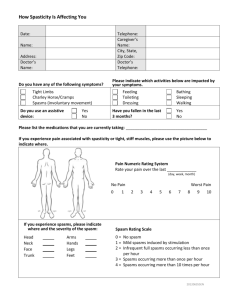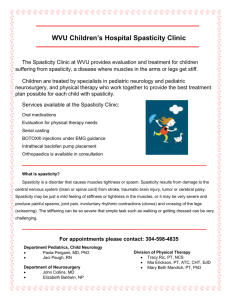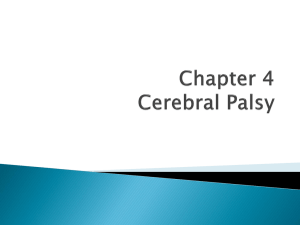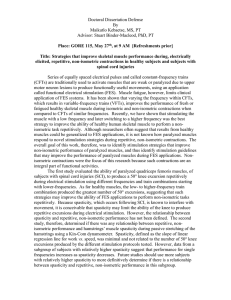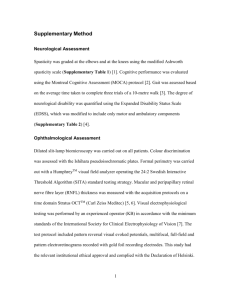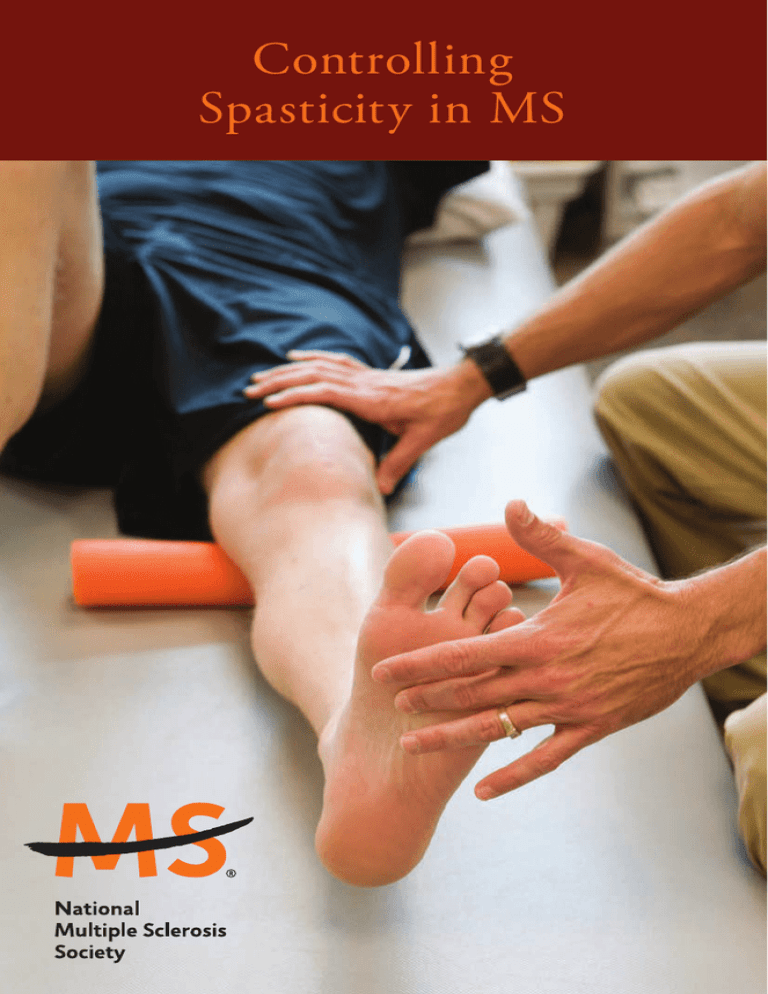
Controlling
Spasticity in MS
Controlling
Spasticity in MS
BY NA NCY J. HOLL A ND, EdD,
W ITH SER ENA STOCK W ELL
Nancy J. Holland is a past vice president of Clinical Programs at
the National Multiple Sclerosis Society. Serena Stockwell is a
professional science writer.
Reviewed by James Bowen, MD; Sharon Dodge, MS activist;
Barbara Giesser, MD; Pat Kennedy, RN, CNP, MSCN; Sue
Kushner, MS, PT; Jerry Wolinsky, MD.
© 2016 NATIONAL MS SOCIETY. ALL RIGHTS RESERVED.
Introduction
Spasticity is one of the most challenging of all MS
symptoms. It comes and goes. It feels different to different
people — and even to the same person at different times.
There are even occasions when a healthcare practitioner
finds spasticity, but the person affected has no symptoms.
What is spasticity?
The word spasticity refers to involuntary muscle stiffness
or spasms (sudden muscle contractions).
In any coordinated movement, some muscles relax while
others contract. Spasticity occurs when this coordination is
impaired and too many muscles contract at the same time.
MS-related spasticity can occur with active movement or be
present at rest. It can cause a leg to lock up and refuse to bend.
Though not completely understood, spasticity is thought
to be caused by increased sensitivity in the parts of muscles
responsible for tightening, relaxing and stretching. In MS, this
likely occurs as a result of demyelination of the nerves in the
central nervous system that control impulses to the muscles.
In mild cases, the condition is noticeable only as a feeling
of tight or stiff muscles. When the condition is severe, the
person can experience painful spasms or twisted limbs,
which can impede mobility and other physical functions.
There are two types of MS-related spasms: flexor and
extensor. Flexor spasticity is defined as an involuntary
1 | Controlling Spasticity in MS
bending of the hips or knees up toward the chest (mostly
involving the hamstring muscles on the back of the upper
leg). Extensor spasticity is an involuntary straightening
of the legs, mostly involving the quadricep muscles (front
of the upper leg), the adductors (inner thigh muscles)
and trunk. In extensor spasticity, hips and knees remain
straight with the legs very close together or crossed over at
the ankles. MS-related spasms can interfere with walking,
climbing stairs, transfers, and balance and coordination.
Spasticity may affect the upper extremities, but is more
common in the lower extremities. Shoulder musculature,
elbows, wrists and hands may be impaired in some people
with MS. Any upper extremity spasticity may greatly
interfere with normal functioning and activities of daily living
including bathing, eating, handwriting, dressing and typing.
How common is spasticity?
Spasticity is one of the more common symptoms of MS.
If all degrees of spasticity are taken together, it occurs in
an estimated 80 percent of people with the disease. The
question of degree is important. For one person, spasticity
may cause a stiff leg, while in another, it makes walking
impossible. For many people, the extra effort needed to
move around – when muscles are spastic – contributes
significantly to fatigue. On the other hand, spasticity can
also compensate for muscle weakness, making it easier to
stand, walk and move.
National MS Society | 2
Treatment
The treatment partnership
Because the condition is so individual, successful treatment
of spasticity demands a true partnership between you and
your healthcare team (doctor, nurse, physical therapist and/or
occupational therapist). Your family also plays an important
role. The first step in building a good treatment partnership
is learning about the range of available treatment strategies.
“Treating spasticity is not a matter of the doctor writing
out a prescription for pills and saying come back in three
months,” said Charles R. Smith, MD, director of the MS
program, Scripps Clinic, La Jolla, CA.
The presence and degree of spasticity can be determined by
your healthcare practitioner. He or she will stretch your legs
to check for involuntary resistance. For example, if your leg
is spastic, your muscles will automatically resist when it is
moved quickly. If spasticity is mild, there will be minimal
resistance; if the spasticity is severe, your leg may be so stiff
that it cannot be bent at all. Overactive reflexes are also an
indication of spasticity.
Treatment begins with your physician recommending
ways to relieve the symptoms. Strategies may include
exercise, medication and/or changes in daily activities.
To individualize your plan and adjust the dosage of any
medication to its most effective level, your doctor will
3 | Controlling Spasticity in MS
need to follow your progress. He or she may also make
referrals to other healthcare professionals, such as a
physical therapist (PT) or occupational therapist (OT).
Nurses, who normally have responsibility for health
education and for learning in detail how patients’ daily
lives are affected by their symptoms, are an important part
of this process. Take the time to ask your nurse questions
and provide personal information. Both your doctor and
nurse will guide you through the sometimes tricky process
of medication adjustment. In addition, the PT and OT
can provide individualized training with specific exercises
and ways to make daily activities easier.
Self-help
Spasticity, like other aspects of your MS, is unique to you.
As with other MS symptoms, spasticity tends to come
and go and to be worse under certain conditions. Typical
triggers include cold temperatures, high humidity, tight
clothing, tight shoes, constipation, poor posture, viral
infection such as a cold or the flu, or bacterial infection
including skin sores or bladder infections. Sometimes
women will notice changes in spasticity related to their
menstrual cycles.
In time, you will become aware of the triggers that affect
you most. Some, like tight shoes, can be avoided. Other
triggers merit an intervention.
National MS Society | 4
Effective self-help means:
n Don’t
assume that nothing can be done! Spasticity does not
have to be tolerated and improvement is usually possible.
n Make
sure that an appropriate exercise program is a regular
part of your routine. The National MS Society’s illustrated
booklets, Stretching for People with MS and Stretching with a Helper for People with MS include exercises specifically for spasticity. Ask your physical therapist, nurse or doctor for recommendations to meet your individual needs.
n Explore complementary relaxation techniques such as progressive
muscle relaxation, yoga, meditation or deep-breathing exercises.
None of these is a cure, but they can make it easier to sleep at
night and face the next day’s problems with a clearer head and
reduced spasticity.
n If
your healthcare provider agrees, explore massage. You may even receive some insurance reimbursement depending on your plan. Massage can help relax muscles and enhance range of motion and may be helpful in preventing pressure sores. Massage should not be used if pressure sores or reddened areas of skin are present. The American Massage Therapy Association has a national locator service and can supply names of qualified therapists. Call 877-905-0577 or visit amtamassage.org.
n
Be patient but persistent through the adjustments in daily activities, the types and doses of medication, the type and timing of exercise, and the use of devices, gadgets and adaptations.
5 | Controlling Spasticity in MS
Treatment goals
Spasticity interferes with daily activities, so the primary
goal of treatment is to reduce the negative effects as much
as possible. Sections of this booklet detail what can be
accomplished by physical therapy, medication, orthotic
devices (splints or braces) and occupational therapy.
Some strategies seek to relieve the affected muscles; others
involve learning to work around spasticity by adopting
new ways of doing things.
Treatment also aims to prevent the serious complications
of spasticity. These include contractures (frozen or
immobilized joints) and pressure sores. Since these
complications also act as spasticity triggers, they can set
off a dangerous escalation of symptoms. Surgical measures
are considered for those rare cases of spasticity that defy
all other treatments.
Contractures are not only painful and disabling, but can
become permanent if left untreated, resulting in upper or
lower extremities that may not regain full range of motion
or may experience limited joint mobility. Treatment (and
prevention) of contractures usually combines medication to
relieve spasticity with physical and occupational therapy.
National MS Society | 6
Pressure Sores
Pressure sores, sometimes called bed sores or pressure ulcers,
occur in people who spend much of their day sitting or
lying down. The term “bed sore” is misleading. One does
not need to be in bed all the time to be at risk for a pressure
sore. MS reduces the thousands of small movements people
ordinarily make both in sleep and while sitting down. MS
can dull sensation in the buttocks or legs, eliminating the
usual sensory cues to change one’s position.
Spasticity contributes to pressure sores by making normal
movement more difficult and by causing posture changes
that create pressure points. Another cause of pressure sores
is “shearing,” which occurs when the person is receiving
positioning assistance from someone, and the movement is
more sliding or dragging than lifting.
Pressure sores begin innocently enough, as small reddened
areas. The spot may not even feel painful or tender. However,
there may already be significant damage to the soft tissues
underneath reddened areas of skin. If pressure on the area is
not relieved, the skin will break down, forming a sore. These
sores can deepen quickly. They are prone to infection, and
they can eventually destroy large areas of underlying tissue
and even bone. Your healthcare practitioner can provide
instruction in prevention and early detection.
Controlling spasticity is part of good pressure sore
prevention. Complicated, infected pressure sores are a
contributing factor in some MS-related deaths.
Rehabilitation
Physical therapy
A physical therapist (PT) recommends and teaches specific
exercises and movements that can increase flexibility and
relieve or decrease spasticity. They may also use bracing and
assistive devices for spasticity treatment.
First, you will have several tests that measure muscle
tone, resistance, strength, balance and coordination.
You’ll also be asked about your general functioning in
routine daily activities. Your ambulation or mobility will
most likely be assessed.
In addition to stretching exercises you do yourself, PTs also
relieve spasticity with specific exercises (done with the help
of another person) to stretch and relax shortened muscle
fibers, increase joint movement, extend contracted muscles
and improve circulation. Some of these techniques may be
taught to a family member or helper so that they can be
performed on a routine basis at home. Physical therapy can
also help maintain range of motion to prevent contractures.
Strengthening exercises prescribed by the PT are important
because a muscle that is spastic is not necessarily strong.
7 | Controlling Spasticity in MS
National MS Society | 8
And strengthening the spastic muscles, as well as the
muscles that oppose the spastic ones, may be particularly
beneficial. This is like making sure that both the “push” and
the “pull” of the muscles are in good condition.
Hydrotherapy (therapy done in the water) may also be
recommended as well as local application of cold packs.
Hydrotherapy is a very effective way to temporarily relax
spastic limbs, especially when used in combination with
gentle stretching.
For those who are unable to stand independently, a
standing frame allows for stretching of leg muscles, as
well as pressure on the leg bones, which helps limit bone
mineral loss (osteoporosis).
Orthotic devices
Orthotic devices (such as braces and splints) maintain
the leg in a more normal position, which makes it easier
to move around or get into a more comfortable position.
These devices should be fitted by a professional. A
common example is the ankle-foot orthosis (AFO), which
places the ankle in a better alignment. Although many
drugstores and catalogs offer them over-the-counter, illfitting devices can aggravate spasticity and cause pressure
sores or pain. Therapists can direct you to the best options
and teach you how to use orthotics.
9 | Controlling Spasticity in MS
Occupational therapy
Occupational therapists (OTs) are experts in modifications
that make daily life with spasticity more comfortable and
enhance independence. Individualized training can be
very helpful in making daily activities such as dressing
and showering easier and more energy efficient. Home
modifications might include replacing small drawer pulls
with large knobs, spraying drawer tracks with silicone to
make the drawers glide, or lowering the clothes bar in your
closets. Your OT may recommend assistive devices and
will often have samples to let you try in order to determine
what works best. You may be amazed at the ingenuity of the
available devices.
Here is a small sample:
n Dressing
n
aids: These include stocking aids, long-handled shoehorns and shoe/boot removers, which allow you to dress with a minimum of bending if you are experiencing stiffness in your trunk or legs; elastic shoelaces that let you slip in and out of shoes without having to retie them; zipper pulls and more.
Toiletry and grooming aids: In addition to electric shavers and electric toothbrushes, there are easy-grip handles for shaving-cream cans, combs or brushes, long-handled brushes for washing your feet, and other tools to help you extend your reach while bathing.
For people who use wheelchairs, OTs may also recommend
positioning changes that minimize spasticity. Sometimes
National MS Society | 10
simple adjustments in the height of a footrest or the width
of a seat along with an appropriate seat cushion can make
a world of difference.
OTs can also develop exercise programs for your hands and
arms, and may recommend splints that position the hands
to enhance function and preserve joint mobility.
Medications
There are two medications that are FDA approved for
the treatment of spasticity, and other medications used
“off label” that can serve well in certain situations. The
two approved medications are baclofen and tizanidine.
The most effective dosage will depend on striking a
balance between the medication’s good and bad effects.
An effective dosage tends to vary from time to time. An
infection, cold weather, an ingrown toenail — whatever
triggers your spasticity — will also influence the amount of
medication needed to manage the muscle stiffness.
Typically, the doctor will increase the dose of medication
gradually until the full benefit is evident, and reduce the
dose if side effects occur. In addition, your healthcare
team can suggest timing your medication in specific
situations. For example, taking an antispasticity
medication an hour before sexual activity can prevent
painful spasms during orgasm.
11 | Controlling Spasticity in MS
Baclofen
Baclofen (Lioresal®) is a muscle relaxant that works in the
spinal cord. It is most often taken three or four times a
day, and common side effects are drowsiness and muscle
weakness. Baclofen relaxes normal as well as spastic muscles.
Nausea, a less common side effect, can usually be avoided
by taking baclofen with food. The medication has a good
safety record with long-term use. The side effects don’t
build up or become worse over time. At high doses, this
medication reduces concentration and contributes to fatigue.
Because it usually restores flexibility within a short period,
baclofen may allow other treatments, such as physical
therapy, to be more effective. Baclofen does not cure
spasticity or improve coordination or strength. A gradual
increase in dosing often allows for higher and more effective
doses to be taken. Baclofen should not be greatly reduced or
stopped suddenly without consulting with your physician
because seizures and other problems can result.
“Intrathecal” baclofen
Some people require a higher dose of baclofen but cannot
tolerate the increased side effects. A surgically-implanted pump
can deliver very small amounts of the medication directly into
the fluid that surrounds the spinal cord. The baclofen pump
has been extremely successful. The pump can improve (or at
least maintain) a person’s level of functioning and may even
help some people remain ambulatory. Furthermore, the pump
permits people with very limited mobility to be positioned to
minimize pain and the risk of pressure sores.
National MS Society | 12
The computer-controlled, battery-operated pump, which
weighs about six ounces, is surgically implanted under the
skin of the abdomen. A tube runs from the pump to the
spinal canal. The pump is programmed to release a pre-set
dose specific for the individual. People who use the pump
are seen by their physician or nurse for a new supply of
medication and a check of the computer program every one
to three months. New medication is injected into the pump
through the skin. The little computer can be reprogrammed
painlessly by radio signals. When the battery wears out (in
five to seven years) the pump itself is surgically removed
and replaced. The tube remains in place.
Tizanidine
Tizanidine (Zanaflex®) works quickly to calm spasms
and relax tightened muscles, but may cause greater
sedation than other medications. Tizanidine is typically
taken three times a day. In addition to drowsiness, dry
mouth is a common and usually temporary side effect.
Hypotension (low blood pressure) is another potential,
but less frequent, side effect.
This medication also has a good safety record with longterm use. It does not cure spasticity or improve muscle
coordination or strength. A combination of baclofen and
tizanidine may give the best results. Tizanidine should be
used with caution with ciprofloxacin HCI (Cipro®), which
is used to prevent or treat urinary tract infections, since
increased drowsiness or sleepiness can occur.
13 | Controlling Spasticity in MS
Diazepam
In small doses, diazepam (Valium®) may also be used in
spasticity treatment. This medication is not as effective as
those mentioned above, but it has the benefit of relieving
anxiety, which makes it easier for someone who is restless
or has disturbing night-time spasms to relax and get a
good night’s sleep.
Drowsiness and potential dependency with long-term
use make diazepam a less desirable choice. However, in
some circumstances, diazepam and another antispasticity
drug may be prescribed together. People for whom this
works say that they would rather be a bit sluggish and
fully flexible than wide awake and spastic. Because they
cause drowsiness, diazepam and clonazepam (Klonopin®),
a similar medication, are generally prescribed to help
control spasms at night.
Gabapentin
Gabapentin (Neurontin®) is used to control some types
of seizures in epilepsy. In MS, gabapentin controls
certain types of pain and can reduce spasms caused by
spasticity. The most common side effects include blurred
or double vision, dizziness and drowsiness. Once you’ve
started on it, gabapentin should not be stopped without
consulting your physician.
National MS Society | 14
Dantrolene
Dantrolene sodium (Dantrium®) is generally used only if
other medications (alone or in combination) have been
ineffective. It works by weakening muscles, making it a
poor choice for people who walk. Dantrolene can produce
serious side effects, including liver damage and blood
abnormalities. The longer a person takes this medication,
the more these problems are likely to develop. People
taking dantrolene must have periodic blood tests.
Levetiracetam
Levetiracetam (Keppra®) is another medication used for
seizure control in some forms of epilepsy. In MS, it can
sometimes be helpful in improving spasticity and spasms.
Side effects and treatment considerations are similar to
those seen with gabapentin.
Botulinum toxin
Injection of botulinum toxin (Botox®) has been shown to
relieve spasticity in small muscles such as those around
joints in the arms and legs. However, the benefit is limited
to the specific muscles that are injected, which means
that this medication is not the appropriate treatment
for generalized spasticity or spasticity in large muscle
groups. In order to avoid the spread of the medication
to neighboring muscles, only small amounts of the
medication can be injected at a time. The effects of each
treatment last approximately three months and then must
15 | Controlling Spasticity in MS
be repeated. Treatment is not given more frequently than
every three months in order to reduce the risk of antibodies
developing that would block its effectiveness. Side effects
include weakness of the injected muscle and some nearby
muscles, and a brief “flu-like” syndrome. In March
2010, the U.S. Food and Drug Administration approved
botulinum toxin for treatment of spasticity in the flexor
muscles of the elbow, wrist, and fingers in adults with MS.
Phenol
Another treatment is the injection of a nerve block called
phenol. This treatment also needs to be repeated every
three to six months, and is often effective when oral agents
have had unsatisfactory results.
A Final Option
Severe Spasticity
Enormous progress has been made in controlling spasticity
in the past two decades. If none of the treatments discussed
above have helped, surgery might be recommended for relief.
The relief is permanent, but so is the resulting disability.
The techniques include severing tendons (tenotomy) or
nerve roots (rhizotomy) in order to relax cramped-up
muscles. These measures are only undertaken after serious
consideration and for the most difficult cases of spasticity.
National MS Society | 16
The most effective way to avoid the need for this type of
surgery is to identify and address spasticity when it begins –
and continue to manage it over time – in order to maintain
your comfort, flexibility and mobility while preventing the
complications associated with untreated spasticity.
Notes:
Botox® is a registered trademark of Allergan, Inc.
Cipro® is a registered trademark of Bayer Aktiengesellschaft.
Dantrium® is a registered trademark of Proctor and Gamble.
Keppra® is a registered trademark of UCB Pharma, S.A.
Klonopin® and Valium® are registered trademarks of Hoffman-LaRoche, Inc.
Lioresal® is a registered trademark of Ciba Geigy Corp.
Neurontin® is a registered trademark of Warner Lambert Co.
Zanaflex® is a registered trademark of Elan Pharmaceuticals Inc.
17 | Controlling Spasticity in MS
National MS Society | 18
Notes:
The National Multiple Sclerosis Society (“Society”) is proud to be
a source of information on multiple sclerosis related topics. The
information provided is based on professional advice, published
experience, and expert opinion, but does not constitute medical
or legal advice. For specific medical advice, consult a qualified
physician. For specific legal advice, consult a qualified attorney.
The Society does not endorse products, services or manufacturers.
Such names appear here solely because they are considered helpful
information. The Society assumes no liability for the recipient’s
use of any product or service mentioned. The Society does not
independently verify whether the information provided by each
service provider is accurate. The Society undertakes no responsibility
to verify whether the service provider is appropriately licensed and
certified and has applicable insurance coverage.
Early and ongoing treatment with an FDA-approved therapy
can make a difference for people with multiple sclerosis. Learn
about your options by talking to your healthcare professional and
contacting the National MS Society at nationalMSsociety.org or
1-800-344-4867.
The Society publishes many other resources about various
aspects of MS. Visit nationalMSsociety.org/brochures or call
1-800-344-4867.
Other popular resources include:
n
n
n
n
n
n
19 | Controlling Spasticity in MS
n
Exercise as Part of Everyday Life
Fatigue: What You Should Know
Gait or Walking Problems: Basic Facts
Managing MS through Rehabilitation
Stretching for People with MS
Stretching with a Helper for People with MS
Taming Stress in MS
National MS Society | 20
The National MS Society’s mission is for people affected
by MS to live their best lives as we stop MS in its tracks,
restore what has been lost and end MS forever. To fulfill
this mission, the Society funds cutting-edge research,
drives change through advocacy, facilitates professional
education, collaborates with MS organizations around
the world, and provides services designed to help people
with MS and their families move their lives forward.
nationalMSsociety.org
1-800-344-4867
21 | Controlling Spasticity in MS
©2016NationalMSSociety.Allrightsreserved. ES60377/16


